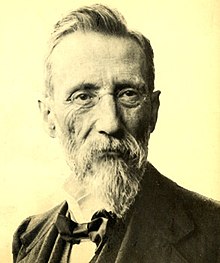Anarchism in Switzerland
Anarchism in Switzerland appeared, as a political current, within the Jura Federation of the International Workingmen's Association (IWA), under the influence of Mikhail Bakunin and Swiss libertarian activists such as James Guillaume and Adhémar Schwitzguébel.
Swiss anarchism subsequently evolved alongside the nascent social democratic movement and participated in the local opposition to fascism during the interwar period.
In August 1291, an alliance was formed between the cantons of Uri, Schwyz and Unterwalden, establishing the Swiss Confederacy with imperial immediacy, which allowed for the territory's autonomy from the Holy Roman Empire.
During the Protestant Reformation, social inequality grew significantly, as more political and economic power became concentrated in the hands of a few rich families, which began to draw resentment from peasants and free citizens.
As liberal and radical groups attained more power,[1] they began to institute widespread reforms including the abolition of censorship, the separation of church and state, the recognition of popular sovereignty and the introduction of representative democracy.
[3] The re-establishment of the Swiss confederation in 1848 provided a safe haven for many European revolutionaries, many of which had been forced into exile by the monarchist regimes that largely ruled the continent at the time.
[4] In September 1866, the IWA convened its first congress in Geneva, during which the French mutualists came to dominate the discussion, with native Swiss trade unions and educational societies also in attendance, concluding its activities by taking up the demand for the universal establishment of the eight-hour day.
This congress saw the participation of a number of prominent anarchists, including Mikhail Bakunin and Élisée Reclus, who joined the league's central committee.
[10] In September 1869, the IWA's fourth congress was convened in Basel, in which the Swiss delegates included the anarchists James Guillaume and Adhémar Schwitzguébel.
This congress saw the French section, which was largely composed of mutualists such as Henri Tolain, Eugène Varlin and Benoît Malon, become isolated from the International by the growing Marxist faction.
The federation published the Sonvilier Circular in 1871, which aligned it against hierarchical political parties and advocated for horizontal revolutionary organizations that modelled themselves after the future society they wished to bring about.
The Congress of the Marxist section proved to be a failure, as only a small number of regional federations participated and the General Council was itself unable to attend, leading it to eventually dissolve itself.
[25][26] The anti-strike rhetoric that followed in their wake saw a surge in anti-semitic and xenophobic conspiracy theories, which blamed the strikes on Jewish speculators and foreign anarchist revolutionaries.
In 1900, Il Risveglio anarchico was established by a group of Italian emigrants and exiles, led by Luigi Bertoni, in collaboration with Romand anarchists such as Jean Wintsch and Jacques Gross.
[32] After the outbreak of World War I, when the Social Democratic Party began to pursue the policy of Burgfrieden, they received criticism from a number of far-left groups, including even the Young Socialists, who had come under the influence of the anarchist physician Fritz Brupbacher and the pacifist theologian Leonhard Ragaz.
[33] Anarchic tendencies continued to proliferate within the Young Socialists throughout the 20th century, particularly in the Bern section, which eventually began pushing for the abolition of the Social Democratic Party's central presidium.
[35] The issues of Le Falot criticized the war as an "absurd massacre" and held that the remedy to the present conditions was through trade union organization.
[36] The Dada movement also emerged in Zürich out of a reaction to the war, developing an art style from anti-capitalist and anarchist philosophies that expressed itself through nonsense and irrationality.
These fears of revolution led to the Federal Council deploying a military occupation of Zürich in November 1918, claiming that due to the economic and political instability the troops were needed to maintain order.
[39] The OAK responded to these altercations by proclaiming a general strike and calling for nine demands, including the institution of proportional representation, women's suffrage, the 48-hour week and the reorganization of the military into a "people's army".
[41] Clovis-Abel Pignat, on the first page of Le Falot of December 1, analyzed the situation and proposed to adopt a program in case of victory of the Revolution in Valais.
[52] A counter-demonstration was called by the Swiss left-wing, with anarchist protestors being organized by Lucien Tronchet and André Bösiger, in order to shut down the meeting.
Between 4,000 and 5,000 protestors gathered at Plainpalais, a few anarchists were among the demonstrators to breach the police cordon and briefly gain access to the building and attempt to disrupt the meeting, before being thrown out.
[59] In 1979, the environmentalist activist Marco Camenisch sabotaged a power station at Bad Ragaz with explosives, himself being arrested not long after and also escaping from prison.
While Swiss anarchism has historically been a phenomenon in Romandy, in 2010 Libertarian Action Winterthur (LAW) was founded in Zürich and has organized anarchist festivals and bookfairs in German-speaking Switzerland.











